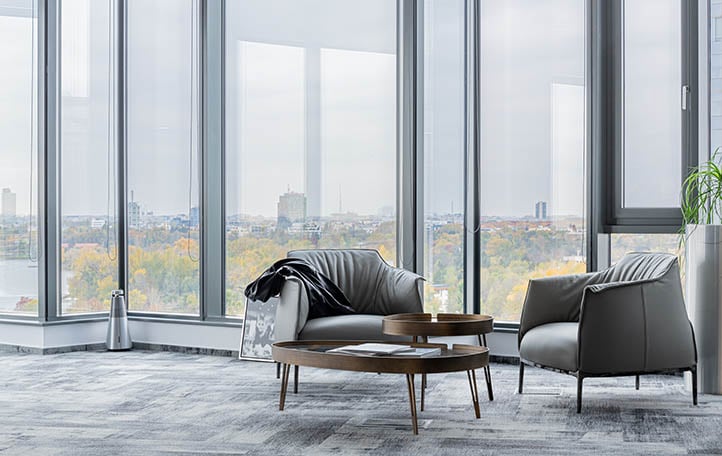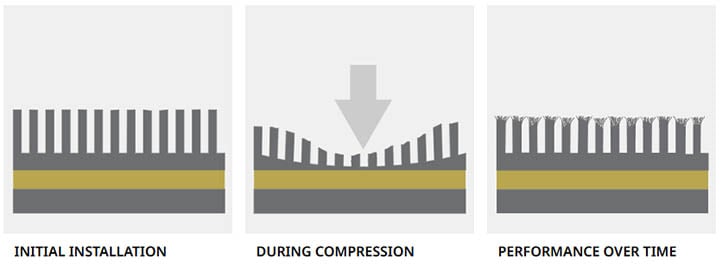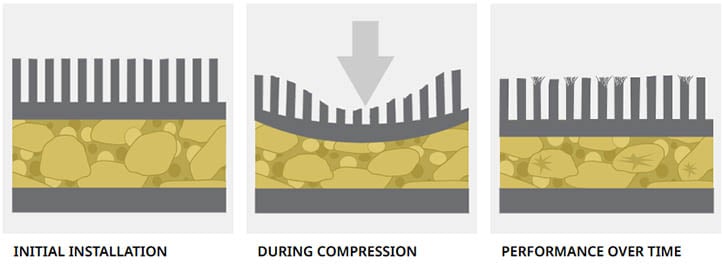When selecting new carpet, you're weighing various priorities depending on your client's needs: aesthetics, budget, longevity and practical requirements. If your client's top priority is creating a long-lasting space, then selecting the most durable carpet available is essential. But what affects carpet durability, and how do you know the carpet you've chosen will continue to perform well and look beautiful in years to come?
Four Factors that Impact Carpet Durability
- Carpet tile backing system. In hard-backed tiles, the carpet fibres directly absorb the impact of foot traffic, which damages the fibres and causes the appearance of your carpet to deteriorate. Cushion backing helps to absorb some of the impact of foot traffic, reducing fibre wear and extending the life of the carpet tile.
- Design and colour. Patterns and dark-coloured carpets are better at disguising stains and spills than solid or light-coloured carpet, allowing the carpet to look like new for longer.
- Soil and stain protection. Many carpet manufacturers offer floor coverings with stain or soiling protection, which makes them easier to keep clean.
- Yarn density. Put simply, the closer carpet pile is packed together, or the denser it is, the longer it will last.

How to Select the Most Durable Carpet
With so many factors affecting carpet durability, it can seem impossible to find one that meets each facet while also providing a design statement. To select the most durable carpet, it's critical to understand which factors have the most significant impact on durability and prioritise those features.
Here are the three factors that have the biggest impact on carpet durability and longevity.
1) Type of Carpet
Does the project call for modular carpet tiles or broadloom carpet? The type of carpet you select will have a big impact on how easy it is to repair and spot-replace in the years to come – and how long the carpet lasts.
Carpet tiles are easier to spot-replace in worn or damaged areas than broadloom. If you want to replace a damaged section of broadloom, you need to cut out the stained piece and replace it with a same-size new section. However, the new section likely won't colour-match the existing floor, creating a ‘patchwork’ effect that means the new section is often more noticeable than the old, damaged section.
In contrast, modular flooring allows you to remove damaged carpet tiles and replace them with new modules from your attic stock. This is a much less labour-intensive process, and the difference between new and old tiles will be much less obvious – keeping your carpet looking beautiful for longer, without the need for a complete replacement. Choosing glue-free installation systems like Milliken's TractionBack 2.0 further increases the ease of individual tile replacement. TractionBack 2.0 grips to the floor without the need for any adhesive so when the time comes they can be easily swapped out by simply picking them up. Resulting in a much cleaner, less disruptive replacement than both glue down carpet tiles and broadloom carpet.
2) Carpet Tile Backing
The type of backing on carpet tiles will have the most significant impact on the durability – more than face weight, design, yarn type or design.
The tile backing affects how the carpet fibres are compressed during daily use. A hard backing means the fibres directly absorb the impact of foot traffic, while cushion backing transfers most of that impact to the tile backing.
HARDBACK

However, there are two different types of cushion backing: open cell and closed cell. This subtle difference can significantly impact the longevity of the carpet. Both types of cushion backing compress under foot traffic, and while closed cell cushioning can ‘bounce back’ for a while, after continued use it remains compressed, and the pressure is transferred to the carpet fibres instead.
CLOSED CELL CUSHION

In contrast, open cell cushioning is able to ‘re-inflate’ after compression, protecting carpet fibres more effectively and for longer than closed cell cushion backing. All of Milliken's WELBAC cushioned products are open cell allowing Milliken to offer warranties of up to 15 years.
OPEN CELL CUSHION

3) Design and Colour
Design and colour will have the second biggest impact on carpet durability. In large organisations especially, it’s impossible for custodial staff to find and clean all spills as soon as they occur, so it’s essential that carpet tiles help hide the stains.
On a solid carpet, every little stain will be noticeable. Patterned carpet will be much more forgiving and better at concealing dirt and stains, so your carpet will look like new for longer.
pair durable carpet with effective entrance flooring
Another effective way to ensure your carpet lasts for longer is installing effective entrance flooring into a tiered entryway system. Using three zones that target large debris, dirt and moisture helps to trap contaminants at the door, stopping them from spreading throughout the building. Milliken's OBEX has a range of products designed with each zone in mind. OBEX reduces maintenance cost and improves the longevity of carpet by reducing soiling and staining.







